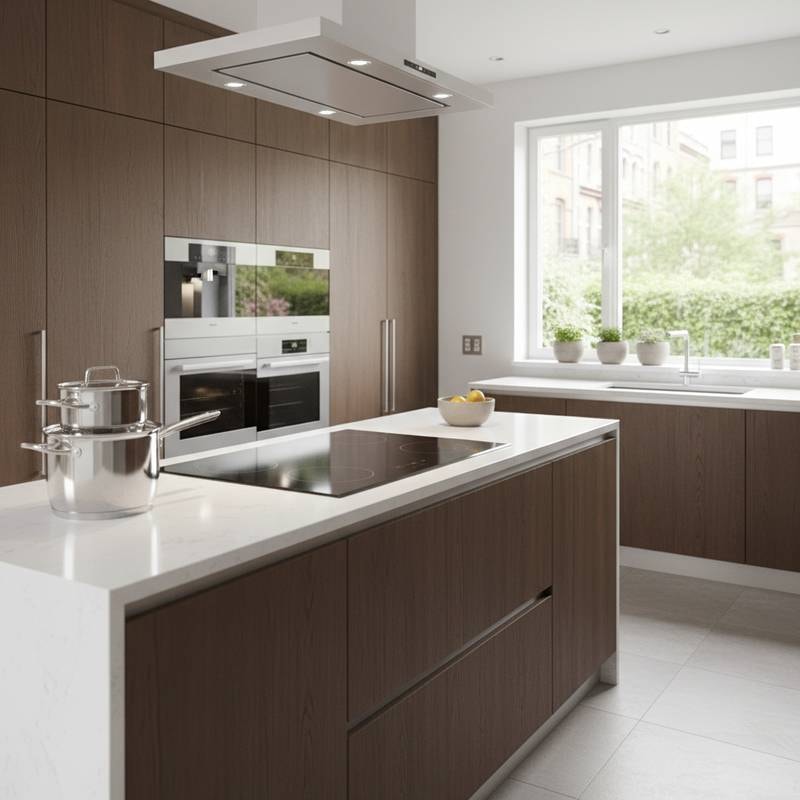Electrify Your Kitchen: The Shift from Gas to Induction
Kitchens serve as the heart of modern homes, where appliances influence daily routines and overall ambiance. Traditional gas stoves have long provided a sense of culinary tradition with their visible flames. However, induction technology introduces a subtle transformation, replacing open flames with magnetic energy that prioritizes efficiency, design harmony, and environmental benefits.
This change extends beyond mere functionality. It reshapes how spaces feel and perform, allowing for cleaner, quieter, and more integrated cooking environments. Homeowners and designers increasingly select induction for its ability to blend advanced performance with aesthetic restraint.
The Subtle Appeal of Induction Design
Induction cooktops stand out for their understated presence. A flat glass surface, often in glossy black or integrated with metal frames, merges seamlessly with countertops. This design avoids the bulky elements of gas burners, preserving the clean lines of materials such as marble or quartz.
Interior experts like Patricia Urquiola highlight this quality, describing the energy as contained and purposeful. The result allows countertops to flow uninterrupted, positioning the cooktop as an extension of the surface rather than a separate device.
Achieving Precise Cooking Control
Precision defines induction's core advantage. Magnetic fields heat cookware directly, delivering rapid and uniform temperature adjustments. Water boils in moments, and delicate sauces maintain exact temperatures without fluctuation.
Models like the Gaggenau CX 492 demonstrate this capability through flexible zones that adapt to pan size and position. Such features provide intuitive control, enabling cooks to focus on technique rather than monitoring heat levels.
Enhancing Indoor Air Quality
Health considerations drive many decisions to adopt induction. Gas combustion releases pollutants like nitrogen dioxide, which can compromise air quality in enclosed spaces. Induction operates without flames, eliminating these emissions and reducing reliance on powerful exhaust systems.
Professionals such as Jennifer Weiss from Jennifer Weiss Architecture emphasize this benefit in client projects. The outcome includes fresher air, diminished noise from ventilation, and a less cluttered visual layout that promotes well-being alongside style.
Boosting Energy Efficiency
Induction excels in resource use. Energy transfers almost entirely to the cookware, minimizing waste and keeping surrounding surfaces cool. This efficiency pairs well with complementary appliances, such as electric ovens from Miele or Bosch, to create sustainable kitchen setups.
The approach aligns with broader goals of environmental responsibility. Homeowners achieve high performance without excessive energy consumption, supporting designs that value both innovation and ecological mindfulness.
Integrating with Diverse Materials
The cooktop's slim profile facilitates creative material choices. It embeds effortlessly into counters made from basalt, marble, or custom composites. Cabinetry in shades like Benjamin Moore's Graphite 1603 complements the dark glass, fostering a unified, sophisticated appearance.
This integration turns kitchens into cohesive environments. Designers leverage the technology to craft spaces that evoke gallery-like serenity, where every element contributes to a balanced whole.
Simplifying Maintenance Routines
Ease of care represents another practical draw. Unlike gas stoves with intricate components, induction surfaces require only a quick wipe. This low-maintenance aspect frees time for enjoyment rather than upkeep.
As Nina Farmer of Nina Farmer Interiors observes, such simplicity elevates the kitchen's role as a lived-in area. Under strategic lighting, the clean surface amplifies light reflection, making rooms appear more expansive and inviting.
Creating a Quieter Kitchen Atmosphere
Sound plays a crucial role in kitchen dynamics. Gas appliances generate persistent noise from flames and vents. Induction maintains near-silence, with only faint operational hums during use.
This acoustic shift enhances open-plan layouts. Conversations flow easily, and cooking sessions adopt a more contemplative tone, allowing design elements to connect living and culinary zones without auditory barriers.
Delivering Professional-Grade Results
Serious home cooks often question induction's ability to match gas responsiveness. In practice, it surpasses expectations with immediate heat adjustments for tasks like searing or simmering. Advanced models, including Wolf's Contemporary Induction Range, employ sensors for consistent temperatures.
These tools empower precise outcomes, from flawless reductions to even browning. The technology translates professional techniques into everyday use, offering reliability without complexity.
Navigating the Electrification Trend
The move to induction reflects wider sustainability efforts. Local regulations and home upgrades accelerate the transition from gas infrastructure. Within design circles, emphasis falls on enhancing user experience through thoughtful electrification.
Induction supports ethical and aesthetic priorities. It embodies progress where technological advances enhance rather than overshadow daily life.
Planning a Smooth Switch to Induction
Transitioning requires careful preparation. Assess electrical capacity, as upgrades might prove necessary in established homes. Engage a certified electrician alongside a designer to align the installation with existing layouts.
Specialized providers like Henrybuilt and deVOL Kitchens offer modular systems tailored for induction. For non-permanent options, portable units from Duxtop or Tefal provide accessible entry points without structural changes.
Embracing the Benefits of Induction Living
After installation, the kitchen evolves into a more serene hub. Cooler surfaces and purer air contribute to comfort, while streamlined cleaning routines maintain order. Cooking sharpens in focus, with technology receding into the background.
Adding Personal Elements
Induction complements rather than dominates. Incorporate artisanal tiles, wood accents, or classic fixtures to infuse character. A zellige backsplash, oak counters, or leather seating introduce texture and warmth to the precise setup.
Realizing Modern Kitchen Potential
Induction cooktops mark a pivotal upgrade in home design. They deliver efficient, elegant solutions that prioritize health, sustainability, and style. As electrification advances, these appliances promise enduring value in contemporary living.









